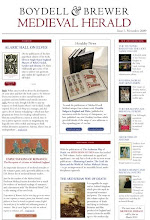How challenging is it to teach subjects focusing on the Middle Ages outside of Europe, in parts of the world which didn’t live through these times?
In our latest Medieval Herald interview (Issue 7 / June 2011) with the editors of our new series Boydell Studies in Medieval Art & Architecture, we asked if it is challenging to teach Medieval Art & Architecture in America.
Professor Asa Mittman of California State University answered:
‘You raise a good question about teaching the Middle Ages in the US. Students here have little to no familiarity with the period and its art. Those fortunate enough to grow up near major collections have some experience of medieval objects. I was raised in New York, and frequented the Metropolitan Museum of Art, the Morgan Library, and other institutions, and interned at the Cloisters Museum. However, my Californian students have not even had this opportunity. Similarly, few of them have travelled to Europe.
There are a few things I to do try to compensate. First and foremost, I am fanatic about the quality of the digital images I use to show them medieval work. I also do my best to invest my lectures with the tactile sense of my experience of medieval structures and objects. Finally, I teach summer study abroad courses (last year at Saint Catharine’s College, Cambridge, and this year at the University of Brighton). It is hard to bring the buildings to Chico, so I bring my students to the buildings.’
Do you see yourself confronted with a similar problem? Do you teach or study the Middle Ages outside of Europe and face similar difficulties? Tell us about your experiences and how you manage to solve this problem.



